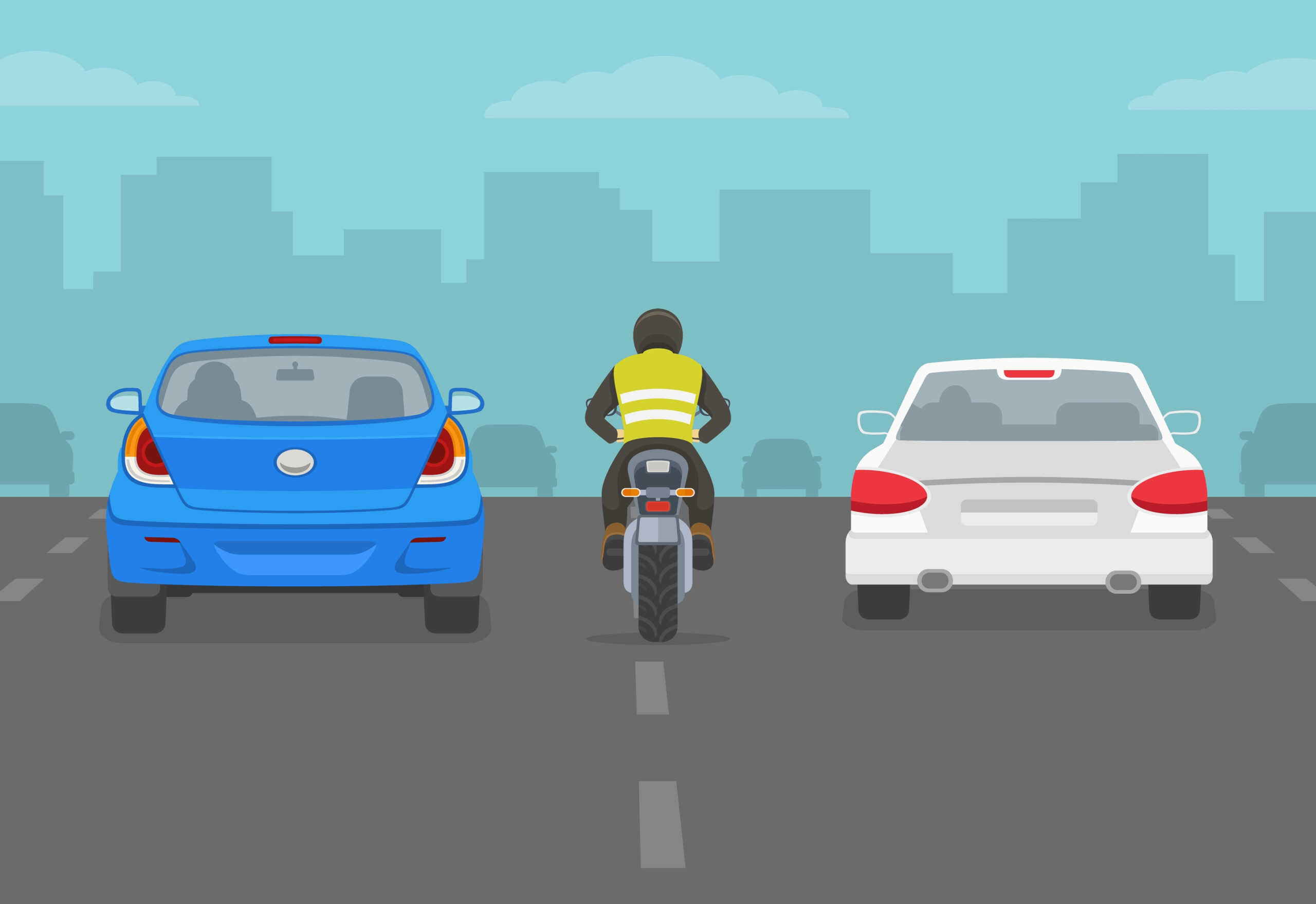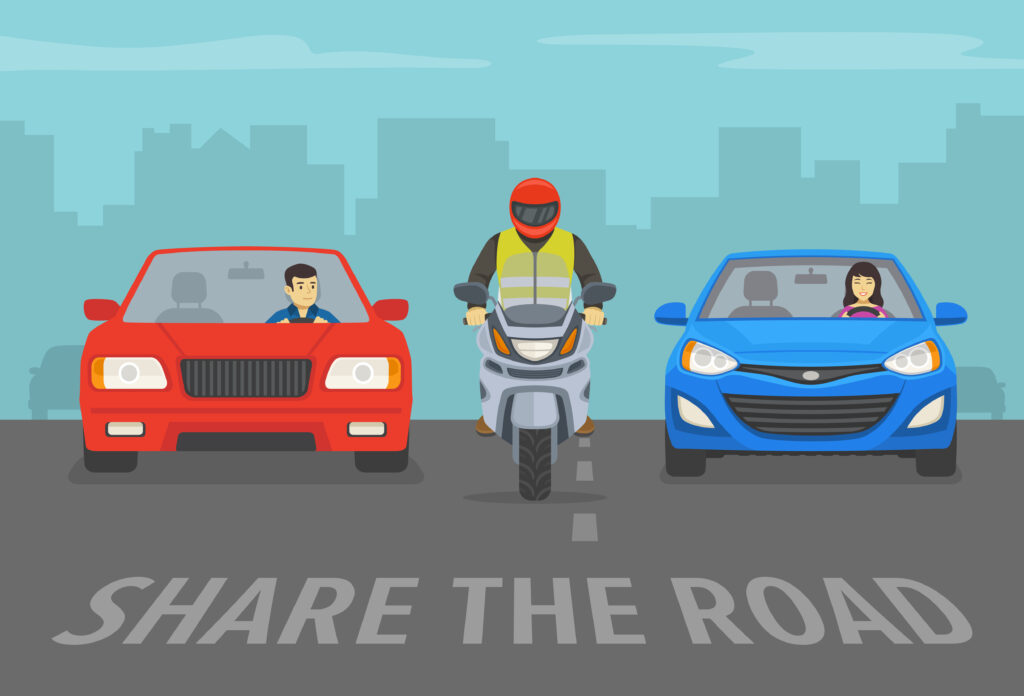
29 Sep Is Lane Splitting Legal in California?
Motorcycles are nimble vehicles that can squeeze into places that larger vehicles cannot. This might encourage riders to drive between designated lanes to get around traffic — but is lane splitting legal in California?
Normally, California motorcyclists are subject to the same traffic laws as other vehicles. As such, you might infer that motorcycles should stick to one lane of traffic and never split. But if you are a motorcyclist in the Golden State, you may have heard other bikers talk about lane splitting as a way to navigate traffic quickly.
Motorcyclists in California can rest easy. If you wonder, “Is lane splitting legal in CA?” the answer is “yes.” But before you start zipping through traffic, you should familiarize yourself with what the California lane-splitting law says and what it allows you to do.
What Is Lane Splitting?
Before addressing the question, “Is lane splitting legal in California?” it is helpful to know what lane splitting is. A motorcyclist engages in lane splitting when they use the space between vehicles traveling in two distinct lanes of traffic going in the same direction as a special lane for their motorcycle.
Travel on any interstate or four-lane highway, and you will see a white dashed line separating two lanes of traffic going in the same direction. The white line exists to tell traffic in one lane where their lane ends and the other lane going in the same direction begins.
Motorists and truck drivers are not to cross over this line. Article 1, Section 21658 of the California Vehicle Code tells motorists that they must stay within a single lane of traffic.
Lane splitting happens when a motorcyclist uses the white dashed line as an additional lane and travels between the vehicular traffic on either side. The motorcyclist “splits” the space between the two marked lanes and carves out space in which to navigate their motorcycle.
The practice of lane splitting can make getting through congested traffic easier for motorcyclists. If motorcyclists were confined to marked lanes, they could find themselves stuck behind slower-moving traffic. It could also be difficult for motorcyclists behind large trucks to see down the road, which could be dangerous.
Benefits and Dangers of Lane Splitting
There is at least one other significant benefit to lane splitting besides being able to see traffic more easily. A presentation by the American Motorcycle Association indicated that bikers who lane split were more likely to avoid serious injury if cars in the adjacent lanes were involved in a crash.
By allowing lane splitting, motorcyclists can escape and get around cars and trucks they see are about to collide or are driving dangerously.
This does not mean that lane splitting is without its risks. Drivers of cars and trucks do not always anticipate motorcyclists or see them easily. This is true when motorcycles travel in the same lanes as other cars and especially when motorcyclists are lane splitting.
Being hit by a car that is changing lanes is a significant risk for motorcyclists who lane split. Therefore, if you choose to engage in this lawful motorcycling practice in California, you should always be mindful of your surroundings and anticipate sudden movements by motorists.
The Lane Splitting Law in California: What Motorcyclists Need to Know
Is it legal for motorcycles to split lanes? This is a common question and a regular topic for debate. Many motorists assume that it’s never allowed. After all, lane splitting is not legal in every state. Type “lane splitting legal states” into a search bar, and the resulting list will not be long.
In fact, if you are looking to see results for “where is lane splitting legal?” California will likely be the first result you see. California is one of the first states to legalize lane splitting and remains one of the few states in the U.S. where the practice is legal.
California Vehicle Code Article 1, Section 21658.1(a) defines lane splitting as driving a motorcycle with both wheels on the ground between rows of vehicles that are stopped or moving on divided and undivided roadways.
This law indicates that the California Highway Patrol can develop guidelines to educate motorcyclists and drivers about lane splitting. The goal of such materials would be to improve road safety and assist in reducing collisions between motorcyclists who are lane splitting and other traffic.
A motorcyclist who chooses to lane split must still obey all other traffic laws. This means that a motorcyclist who lane splits must still obey the speed limit, signal when moving in and out of lanes of traffic, and signal turns before making them. If you do not do so, you can be pulled over and ticketed like any other motorist or biker.
California’s lane-splitting law also regulates the behavior of motorists. Specifically, the law prohibits drivers of cars or trucks from maneuvering their vehicles into the path of motorcyclists who are lane splitting. A motorist might be tempted to do so if they believe the motorcyclist is breaking the law or are frustrated that the motorcyclist is getting ahead of them.
Similarly, it is illegal for a motorist to open their door in the path of a lane-splitting biker. Not only is such a move illegal, but it is also extremely dangerous to the motorcyclist.
Colliding with a door that suddenly opens can send the motorcyclist flying off their bike, leading to brain injuries, spinal cord injuries, and road rash. In some cases, the injuries can be fatal.
How to Lane Split Safely
Per the law, the California Highway Patrol has guided motorcyclists on remaining safe while lane splitting. This advice encourages motorcyclists to:
Use Common Sense When Splitting Lanes
First, you should remain alert to your surroundings and consider whether splitting lanes in a particular situation is a good idea. Remember, just because the law permits you to lane split does not mean you must or even that you should. There may be situations where it is safer to remain in a single lane of traffic along with other vehicles.
Refrain From Lane Splitting in Poor Weather
You should not lane split if the weather has made roads slick or hazardous. Not only could you lose control of your motorcycle, but other motorists changing lanes may also lose control of their vehicles.
Similarly, do not lane split at night on dark roads or at other times when visibility is poor. Riding on a motorcycle and lane splitting already makes it more difficult for motorists to detect you. Lane splitting in these conditions can increase the chance of an unintentional collision.
Do Not Lane Split on the Far Left Lane
On a highway with a center median, lane splitting in the far left lane puts you between traffic and a solid median. This can lead to crushing injuries if you become pinned between these two hazards. On other roads, this could put you dangerously close to traffic that is coming at you from the opposite direction.
Do Not Drive on the Shoulder
Last, you should not lane split so that you are driving on the shoulder of a road. A roadway’s shoulder is for disabled motorists or others experiencing an emergency.
In order to protect those using the shoulder for emergencies, driving on the shoulder is illegal in California. The lane-splitting law does not give you a license to violate other laws like the one prohibiting you from driving on the shoulder.
Wear Appropriate Clothing
Lastly, the California Highway Patrol recommends that you wear bright or reflective clothing at all times so as to make yourself more visible to other traffic.
Lane Filtering vs. Lane Splitting in California
Do not confuse lane splitting with a similar practice called lane filtering. While lane splitting is authorized by California law and is therefore legal, lane filtering is not. If you engage in lane filtering, you could not only be ticketed but also find yourself seriously hurt in an accident.
“What is lane filtering?” you might ask. Lane filtering occurs when motor vehicle traffic is stopped at a light or because of an obstruction, and motorcyclists filter between the lanes of traffic to get to the front of the line. When the obstruction clears or the light changes to green, motorcyclists can then speed off ahead of the cars and trucks.
Therefore, the primary difference between lane filtering and lane splitting is that lane splitting occurs when traffic moves at or near the posted speed limit. Conversely, lane filtering happens when traffic is either stopped or moving at a low speed.
Lane filtering can be more dangerous than lane splitting. When traffic stops because of road work or a traffic signal, all motorists want to be able to get moving again quickly. As a result, car and truck drivers may be more willing to switch lanes quickly and without warning. This can lead to collisions with motorcyclists who are lane filtering to get ahead of stopped traffic.
Remember that while lane splitting is legal in California, lane filtering is specifically unauthorized.
A Word of Caution About Lane Splitting
Just because lane splitting in California is legal does not mean that it is safe. Motorists who do not own or ride a motorcycle may not know what lane splitting is or that California law permits the practice. A car or truck driver might be surprised to see you engage in lane splitting and react unpredictably. This can increase the chance of an accident.
If you do choose to lane split, do so cautiously. Be mindful of other traffic, and be prepared to react quickly to the unexpected movements of other vehicles. Do not combine lane splitting with other reckless behavior, such as speeding or making movements without first signaling your intentions.
Finally, whether you choose to lane split or not, you should always wear a helmet and protective clothing when motorcycling. Wearing a helmet can reduce the risk of a traumatic brain injury by as much as 67 percent, according to the National Highway Traffic Safety Administration.
Assistance for Injured Motorcyclists in Yuba City
Not only can motorcycles split lanes in California, but the law specifically allows them to do so. However, there is risk involved. Remember that you have valuable legal rights if you find yourself injured following a motorcycle wreck in Yuba City or elsewhere in California. These rights include filing a claim for damages and seeking compensation from individuals whose negligence causes you harm.
Filing a motorcycle claim can seem daunting when you are hurt and facing mounting medical bills and other costs. However, you do not need to file a claim or pursue compensation alone. A skilled motorcycle accident lawyer with experience handling such claims can accomplish these tasks on your behalf with minimal effort from you.
Enlist Yuba City motor vehicle accident lawyer Steve Gimblin and the Law Offices of Steve Gimblin when you are hurt. Our experienced firm takes the trust placed in us by clients seriously and pursues their claims diligently.
Whether through a settlement or by taking your case to court, the Law Offices of Steve Gimblin is prepared to fight for your rights. Contact us today for a free consultation to get started.




No Comments